- Home
- Oliver Sacks
The River of Consciousness Page 11
The River of Consciousness Read online
Page 11
I was not sure what to make of this. Was the author too lazy, or too lacking in talent or originality, to make the needed transformation of my work? Or was the problem essentially one of incubation, that he had not allowed himself enough time for the experience of reading Awakenings to sink in? Nor had he allowed himself, as Pinter did, time to forget it, to let it fall into his unconscious, where it might link with other experiences and thoughts.
All of us, to some extent, borrow from others, from the culture around us. Ideas are in the air, and we may appropriate, often without realizing, the phrases and language of the times. We borrow language itself; we did not invent it. We found it, we grew up into it, though we may use it, interpret it, in very individual ways. What is at issue is not the fact of “borrowing” or “imitating,” of being “derivative,” being “influenced,” but what one does with what is borrowed or imitated or derived; how deeply one assimilates it, takes it into oneself, compounds it with one’s own experiences and thoughts and feelings, places it in relation to oneself, and expresses it in a new way, one’s own.
Time, “forgetting,” and incubation are equally necessary before deep scientific or mathematical insights can be achieved. Henri Poincaré, the great mathematician, recounts in his autobiography how he wrestled with a particularly difficult mathematical problem but, getting nowhere, became deeply frustrated.*4 He decided to take a break by going on a geological excursion, and this travel distracted him from his mathematical problem. One day, though, he wrote,
We entered an omnibus to go some place or other. At the moment when I put my foot on the step, the idea came to me, without anything in my former thoughts seeming to have paved the way for it, that the transformations I had used to define the Fuchsian functions were identical with those of non-Euclidian geometry. I did not verify the idea; I should not have had time, as…I went on with a conversation already commenced, but I felt a perfect certainty. On my return to Caen, for conscience’s sake, I verified the result at my leisure.
A while later, “disgusted” with his failure to solve a different problem, he went to the seaside, and here, as he wrote,
one morning, walking on the bluff, the idea came to me, with just the same characteristics of brevity, suddenness and immediate certainty, that the arithmetic transformations of indefinite ternary quadratic forms were identical with those of non-Euclidian geometry.
It seemed clear, as Poincaré wrote, that there must be an active and intense unconscious (or subconscious, or preconscious) activity even during the period when a problem is lost to conscious thought, and the mind is empty or distracted with other things. This is not the dynamic or “Freudian” unconscious, boiling with repressed fears and desires, nor the “cognitive” unconscious, which enables one to drive a car or to utter a grammatical sentence with no conscious idea of how one does it. It is instead the incubation of hugely complex problems performed by an entire hidden, creative self. Poincaré pays tribute to this unconscious self: it “is not purely automatic; it is capable of discernment;…it knows how to choose, to divine….It knows better how to divine than the conscious self, since it succeeds where that has failed.”
The sudden uprush of a solution to a long-incubated problem may sometimes occur in dreams, or in states of partial consciousness such as one tends to experience immediately before falling asleep or immediately after waking, with the strange freedom of thought and sometimes almost hallucinatory imagery that can come at such times. Poincaré recorded how one night, while in this sort of twilight state, he seemed to see ideas in motion, like molecules of a gas, occasionally colliding and coupling in pairs, locking together to form more complex ideas—a rare view (though others have described similar ones, especially in drug-induced states) of the usually invisible creative unconscious.
And Wagner gives a vivid description of how the orchestral introduction to Das Rheingold came to him, after long waiting, when he too was in a strange, quasi-hallucinatory twilight state:
After a night spent in fever and sleeplessness, I forced myself to take a long tramp the next day through the hilly country, which was covered with pinewoods….Returning in the afternoon, I stretched myself, dead tired, on a hard couch….I fell into a kind of somnolent state, in which I suddenly felt as though I were sinking in swiftly flowing water. The rushing sound formed itself in my brain into a musical sound, the chord of E flat major, which continued re-echoed in broken forms; these broken forms seemed to be melodic passages of increasing motion, yet the pure triad of E flat major never changed, but seemed by its continuance to impart infinite significance to the element in which I was sinking….I at once recognized that the orchestral overture to the Rheingold, which must have long lain latent within me…had at last been revealed to me.*5
Could one distinguish, by some functional brain imaging yet to be invented, the mimicries or imitations of an autistic savant from the deep conscious and the unconscious transformations of a Wagner? Does verbatim memory look different, neurologically, from deep, Proustian memory? Could one demonstrate how some memories seem to have little effect on the development and circuitry of the brain, how some traumatic memories remain perseveratively yet unchangingly active, while yet others become integrated and lead to profound and creative developments in the brain?
Creativity—that state when ideas seem to organize themselves into a swift, tightly woven flow, with a feeling of gorgeous clarity and meaning emerging—seems to me physiologically distinctive, and I think that if we had the ability to make fine enough brain images, these would show an unusual and widespread activity with innumerable connections and synchronizations occurring.
At such times, when I am writing, thoughts seem to organize themselves in spontaneous succession and to clothe themselves instantly in appropriate words. I feel I can bypass or transcend much of my own personality, my neuroses. It is at once not me and the innermost part of me, certainly the best part of me.
* * *
*1 In autistic or retarded people with savant syndrome, the powers of retention and reproduction may be prodigious, but what is retained is apt to be retained as something external, indifferently. Langdon Down, who identified Down’s syndrome in 1862, wrote about one savant boy who “having once read a book, could ever more remember it.” Once Down gave the boy a copy of Gibbon’s Decline and Fall to read. The boy read and recited this fluently but without any comprehension, and on page 3 he skipped a line but then went back and corrected himself. “Ever after,” Down wrote, “when reciting from memory the stately periods of Gibbon, he would, on coming to the third page, skip the line and go back and correct the error with as much regularity as if it had been part of the regular text.”
*2 In his autobiography, Ex-Prodigy, Norbert Wiener, who entered Harvard at fourteen to get his doctorate and remained a prodigy all his life, describes a contemporary of his, William James Sidis. Sidis (named after his godfather, William James) was a brilliant polyglot mathematician who enrolled at Harvard at the age of eleven but by sixteen, perhaps overwhelmed by the demands of his genius and of society, had given up mathematics and retreated from public and academic life.
*3 There had been Poe’s Dupin stories (“The Murders in the Rue Morgue,” for example), but these had none of the personal quality, the rich characterization of Holmes and Watson.
*4 Jacques Hadamard relates this in his Psychology of Invention in the Mathematical Field.
*5 There are many similar stories, some of them iconic, some perhaps mythologized, about sudden scientific discoveries coming in dreams. Mendeleev, the great Russian chemist, discovered the periodic table in a dream, it is said, and, immediately on waking, jotted it down on an envelope. The envelope exists; the account, as far as it goes, may be true. But it gives the impression that this stroke of genius came out of the blue, whereas, in reality, Mendeleev had been pondering the subject, consciously and unconsciously, for at least nine years, ever since the 1860 conference at Karlsruhe. He was clearly obsessed by the problem and would spend
long hours on train trips across Russia with a special deck of cards on which he had written each element and its atomic weight, playing what he called “chemical solitaire,” shuffling, ordering, and reordering the elements. Yet when the solution finally came to him, it came during a time when he was not consciously trying to reach it.
A General Feeling of Disorder
Nothing is more crucial to the survival and independence of organisms—be they elephants or protozoa—than the maintenance of a constant internal environment. Claude Bernard, the great French physiologist, said everything on this matter when, in the 1850s, he wrote, “La fixité du milieu intérieur est la condition de la vie libre.” Maintaining such constancy is called homeostasis. The basics of homeostasis are relatively simple but miraculously efficient at the cellular level, where ion pumps in cell membranes allow the chemical interior of cells to remain constant, whatever the vicissitudes of the external environment. More complex monitoring systems are demanded when it comes to ensuring homeostasis in multicellular organisms—animals, and human beings, in particular.
Homeostatic regulation is accomplished by the development of special nerve cells and nerve nets (or plexuses) scattered throughout our bodies, as well as by direct chemical means (hormones, for example). These scattered nerve cells and plexuses become organized into a system or confederation that is largely autonomous in its functioning—hence its name, the autonomic nervous system. The autonomic nervous system was only recognized and explored in the early part of the twentieth century, whereas many of the functions of the central nervous system, especially the brain, had already been mapped in detail in the nineteenth century. This is something of a paradox, for the autonomic nervous system evolved long before the central nervous system.
They were (and to a considerable extent still are) independent evolutions, extremely different in organization as well as formation. Central nervous systems, along with muscles and sense organs, evolved to allow animals to get around in the world—forage, hunt, seek mates, avoid or fight enemies, etc. The central nervous system, along with the proprioceptive system, tells one who one is and what one is doing. The autonomic nervous system, sleeplessly monitoring every organ and tissue in the body, tells one how one is. (Curiously, the brain itself has no sense organs, which is why one can have gross disorders here yet feel no malaise. Thus Ralph Waldo Emerson, who developed Alzheimer’s disease in his sixties, when asked how he was, would say, “I have lost my mental faculties but am perfectly well.”)*1
By the early twentieth century, two general divisions of the autonomic nervous system were recognized: a “sympathetic” part, which, by increasing the heart’s output, sharpening the senses, and tensing the muscles, readies an animal for action (in extreme situations, for instance, life-saving fight or flight); and the corresponding opposite—a “parasympathetic” part—which increases activity in the “housekeeping” parts of the body (gut, kidneys, liver, etc.), slowing the heart and promoting relaxation and sleep. These two portions of the autonomic nervous system normally work in a happy reciprocity; thus the delicious postprandial somnolence that follows a heavy meal is not the state in which to run a race or get into a fight. When the two parts of the autonomic nervous system are working harmoniously together, one feels “well” or “normal.”
No one has written more eloquently about this than Antonio Damasio in his book The Feeling of What Happens and many subsequent books and papers. He speaks of a “core consciousness,” the basic feeling of how one is, which eventually becomes a dim, implicit feeling of consciousness.*2 It is especially when things are going wrong internally—when homeostasis is not being maintained; when the autonomic balance starts listing heavily to one side or the other—that this core consciousness, the feeling of how one is, takes on an intrusive, unpleasant quality, and now one will say, “I feel ill—something is amiss.” At such times, one no longer looks well either.
As an example of this, migraine is a sort of prototype illness, often very unpleasant but transient and self-limiting; benign in the sense that it does not cause death or serious injury and that it is not associated with any tissue damage or trauma or infection. Migraine provides, in miniature, the essential features of being ill—of trouble inside the body—without actual illness.
When I came to New York, nearly fifty years ago, the first patients I saw suffered from attacks of migraine—common migraine, so called because it attacks at least 10 percent of the population. (I myself have had attacks of them throughout my life.) Seeing such patients, trying to understand or help them, constituted my apprenticeship in medicine and led to my first book, Migraine.
Though there are many (one is tempted to say, innumerable) possible presentations of common migraine—I described nearly a hundred such in my book—its commonest harbinger may be just an indefinable but undeniable feeling of something amiss. This is exactly what Emil du Bois-Reymond emphasized when, in 1860, he described his own attacks of migraine. “I wake,” he writes, “with a general feeling of disorder.”
In his case (he had had migraines every three to four weeks since his twentieth year), there would be “a slight pain in the region of the right temple which…reaches its greatest intensity at midday; towards evening it usually passes off…At rest the pain is bearable, but it is increased by motion to a high degree of violence…It responds to each beat of the temporal artery.” Moreover, du Bois-Reymond looked different during his migraines: “The countenance is pale and sunken, the right eye small and reddened.” During violent attacks he would experience nausea and “gastric disorder.” The “general feeling of disorder” that so often inaugurates migraines may continue, getting more and more severe in the course of an attack; the worst-affected patients may be reduced to lying in a leaden haze, feeling half-dead or even that death would be preferable.*3
I cite du Bois-Reymond’s self-description, as I do at the very beginning of Migraine, partly for its precision and beauty (as are common in nineteenth-century neurological descriptions, but rare now), but above all because it is exemplary—all cases of migraine vary, but they are, so to speak, permutations of his.
The vascular and visceral symptoms of migraine are typical of unbridled parasympathetic activity, but they may be preceded by a physiologically opposite state. One may feel full of energy, even a sort of euphoria, for a few hours before a migraine—George Eliot would speak of herself as feeling “dangerously well” at such times. There may, similarly, especially if the suffering has been very intense, be a “rebound” after a migraine. This was very clear with one of my patients (Case 68 in Migraine), a young mathematician with very severe migraines. For him the resolution of a migraine, accompanied by a huge passage of pale urine, was always followed by a burst of original mathematical thinking. “Curing” his migraines, we found, “cured” his mathematical creativity, and he elected, given this strange economy of body and mind, to keep both.
While this is the general pattern of a migraine, there can occur rapidly changing fluctuations and contradictory symptoms—a feeling that patients often call “unsettled.” In this unsettled state (as I write in Migraine), “one may feel hot or cold, or both…bloated and tight, or loose and queasy; a peculiar tension, or languor, or both…sundry strains and discomforts, which come and go.”
Indeed, everything comes and goes, and if one could take a scan or inner photograph of the body at such times, one would see vascular beds opening and closing, peristalsis accelerating or stopping, viscera squirming or tightening in spasms, secretions suddenly increasing or decreasing, as if the nervous system itself were in a state of indecision. Instability, fluctuation, and oscillation are of the essence in the unsettled state, this general feeling of disorder. We lose the normal feeling of “wellness,” which all of us, and perhaps all animals, have in health.
If new thoughts about illness and recovery—or old thoughts in new form—have been stimulated by thinking back to my first patients, they have been given an unexpected salience by a very different pers
onal experience in recent weeks.
On Monday, February 16, 2015, I could say I felt well, in my usual state of health—at least such health and energy as a fairly active eighty-one-year-old can hope to enjoy—and this despite learning, a month earlier, that much of my liver was occupied by metastatic cancer. Various palliative treatments had been suggested—treatments that might reduce the load of metastases in my liver and permit a few extra months of life. The one I opted for, decided to try first, involved my surgeon, an interventional radiologist, threading a catheter up to the bifurcation of the hepatic artery and then injecting a mass of tiny beads into the right hepatic artery, where they would be carried to the smallest arterioles, blocking these, cutting off the blood supply and oxygen needed by the metastases—in effect, starving and asphyxiating them to death. (My surgeon, who has a gift for vivid metaphor, compared this to killing rats in the basement, or, in a pleasanter image, mowing down the dandelions on the back lawn.) If such an embolization proved to be effective, and tolerated, it could be done on the other side of the liver (the dandelions on the front lawn) a month or so later.
The procedure, though relatively benign, would lead to the death of a huge mass of melanoma cells (almost 50 percent of my liver was occupied by metastases). These, in dying, would give off a variety of unpleasant and pain-producing substances and would then have to be removed, as all dead material must be removed from the body. This immense task of garbage disposal would be undertaken by cells of the immune system—macrophages—that are specialized to engulf alien or dead matter in the body. I might think of them, my surgeon suggested, as tiny spiders, millions or perhaps billions in number, scurrying inside me, engulfing the melanoma debris. This enormous cellular task would sap all my energy, and I would feel, in consequence, a tiredness beyond anything I had ever felt before, to say nothing of pain and other problems.

 Uncle Tungsten
Uncle Tungsten Oaxaca Journal
Oaxaca Journal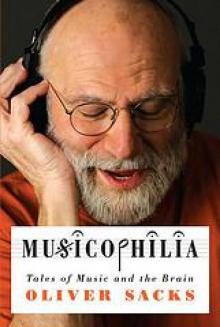 Musicophilia
Musicophilia The man who mistook his wife for a hat
The man who mistook his wife for a hat 1989 - Seeing Voices
1989 - Seeing Voices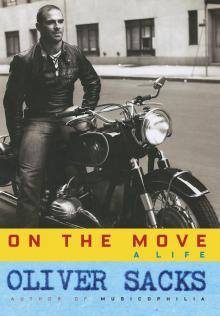 On the Move: A Life
On the Move: A Life 1996 - The Island of the Colorblind
1996 - The Island of the Colorblind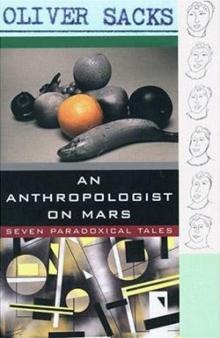 An Anthropologist on Mars: Seven Paradoxical Tales
An Anthropologist on Mars: Seven Paradoxical Tales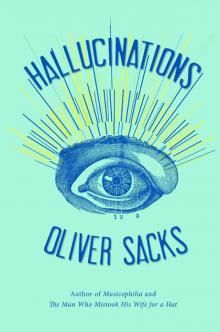 Hallucinations
Hallucinations Seeing Voices
Seeing Voices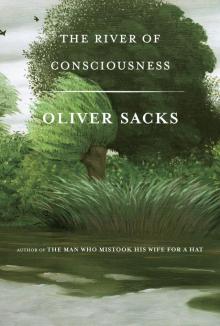 The River of Consciousness
The River of Consciousness Vintage Sacks
Vintage Sacks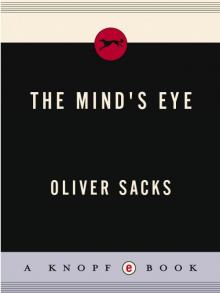 The Mind's Eye
The Mind's Eye Everything in Its Place
Everything in Its Place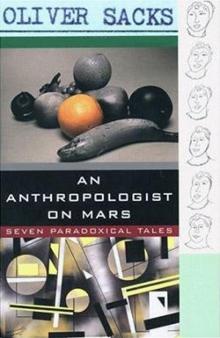 An Anthropologist on Mars (1995)
An Anthropologist on Mars (1995) Uncle Tungsten: Memories of a Chemical Boyhood (2001)
Uncle Tungsten: Memories of a Chemical Boyhood (2001)